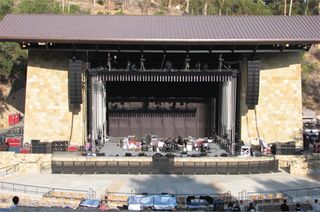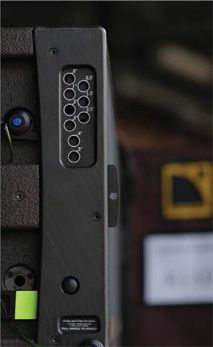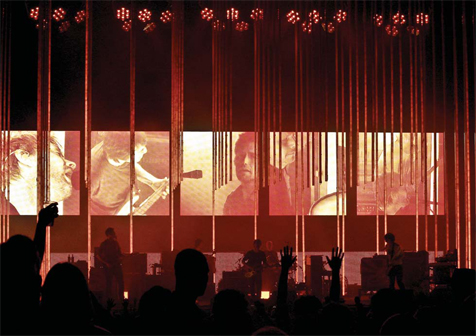- In Hollywood, sequels are often met with some apprehension. Months, or even years, before a release opens in theaters, rumors circulate about the likelihood that the hero will be as dynamic and thrilling as in the original. But generally, if the director and cast are consistent, expectations are extremely high.
- The team at L-Acoustics must feel a little bit like movie stars at this point. The pro audio industry has been abuzz with talk about the new K1 line source system for quite a while, and the fire of intrigue was stoked significantly at the Prolight + Sound trade show in Frankfurt, Germany in April of this year. There, L-Acoustics founder and CEO Christian Heil and director of marketing Stéphane Ecalle revealed the first official clues about the eventual K1 release.
The L-Acoustics K1/KUDO Pilot Program began in August, as Firehouse Productions initiated testing of the system with Radiohead.
A “sequel” rather than a replacement for the revolutionary V-DOSC line array which changed tour sound upon its 1993 launch, the new system combines K1 components with KUDO. In the Prolight interview, Heil commented, “The market expectations for the V-DOSC succession are in line with the V-DOSC reputation, or should I say that the bar has been raised higher! In order to surpass VDOSC, let me just say that we had to put all our ‘know-how’ and our longterm experience of Wavefront Sculpture Technology into the new project. Some very talented system engineers were also involved, and as a result I am confident regarding the superiority of the new K1 system.”
As a manufacturer which trains and certifies its V-DOSC operators and established a network of dealers in order to guarantee perfection in the field, LAcoustics isn’t taking the launch of the K1 system lightly. In August, the company launched a K1/KUDO Pilot Program which will put the system in the hands of L-Acoustics’ touring sound partners for testing over what will likely be a two-year beta term.
“If our ultimate goal is to position K1 combined with KUDO as the new benchmark for the stadium market, we will need to take the necessary time to finalize and validate the system before considering any formal market introduction,” Heil continued in the Prolight interview.
Those eager to get a sonic glimpse of the K1 were given their first chance in August, when Firehouse Productions used the system on the last leg of Radiohead’s North American In Rainbows tour. As if this summer’s Radiohead tour didn’t present enough firsts in the lighting in visuals department, the K1 absolutely raised the bar for concert sound.
INSIDE AND OUT
As has been the case with previous L-Acoustics product innovations, the development of the K1 will likely influence commercial audio installation product lines as well. From an overall technology standpoint, the bevy of line array products which hit the market following V-DOSC’s introduction have certainly found their way into numerous permanent installation applications. But specific to LAcoustics products, V-DOSC innovations informed the development and release of KUDO and KIVA, as well a line of coaxial loudspeaker products.

The new L-Acoustics K1 at the Santa Barbara Bowl on August 28, the last date on the U.S. leg of Radiohead’s In Rainbows tour. “There’s a trickle-down that happens,” explained Paul Freudenberg, LAcoustics U.S. vice president of sales and marketing. “The K1 wouldn’t be the same without our experiences with KIVA, and really every speaker that we produce today is really the beneficiary of all the prior work on products.”
Regarding the prospects for a commercial sound entry, Freudenberg added, “Some of our concepts in looking at the frequency contour for festival operation have made us recognize that under certain circumstances we might be able to replicate that contour with a much smaller concert system.”
The design process within LAcoustics is truly collaborative, and the knowledge of its parts definitely informs the whole. Heil’s background in particle physics is known to audio insiders, and his insight into the way particles form waves have held tremendous influence over the innovations at L-Acoustics. But Heil himself credits the collective knowledge of the engineers at L-Acoustics every chance he gets.
Freudenberg elaborated, “With our team specialized minds in the fields of mechanical engineering, R&D, software, and DSP, every single product is the outcome of a collaborative process where there are no rock stars. There’s no single person who takes the credit and the glory. Christian works hard to foster the collaborative process so everyone takes ownership and shares in the results. It’s very rare that you get that combination of talent and technique.”
DESIGN SCHEMATIC
The collective expertise of the LAcoustics engineering team is bolstered by information gathered from experience in live sound, touring, and permanent installation markets. Inevitably, every product line benefits as real-world data is applied to incremental and ongoing updates in software and hardware.
“The tour sound world is the racing team, if you will,” Freudenberg said. “The idea is to test all our latest concepts on the track. Then we take every major performance advantage, and apply it to our product lines. So, while every venue won’t be appropriate for a full-size K1 line array, the tools and techniques in the manufacturing, implementation, and deployment are used throughout. You get K1 technology even if you’re using KIVA.”
Once a loudspeaker is in production, its attributes are mainly set in stone, but there is an adaptive capability brought by L-Acoustics’ LA4 and LA8 amplified controllers, which increase the longevity of products by imbuing them with new presets via DSP. “The role that the amplified controllers play cannot be over emphasized,” Freudenberg said. “Our opportunity to add incremental improvement lies primarily in our ability to get research from the field regarding applications and operation and then be able to tweak the presets and open up the performance envelope based on the real conditions found in the field.”
Within the DSP L-Acoustics has control over the crossovers and EQ, along with a specialized limiter system and provision for both conventional filtering and linear phase filters. “And the fact that L-Acoustics has overall control of the destiny of the DSP means we are in the driver’s seat and we can take advantage of all the innovations that are happening in this field. We’re not waiting for a provider to put it in a box and bring it to market. We own it, and in effect every amplified controller owner owns it.”
APPLIED SCIENCE
K1 development was informed by countless points of input. Everything from hardware concerns like an entirely revamped rigging system and one-touch grille removal, to aesthetic and of course sonic considerations were poured into the new system.
In setting out to create a new point source array, L-Acoustics kept many variables open, but one thing was certain: “We decided that the full-size line array market needs a new statement,” Freudenberg said.
Among the first development steps was a complete revision of the VDOSC rigging system. Three generations of prototypes eventually produced a much more efficient solution.
When it came to the enclosure and the components within it, testing was even more rigorous. “One of the biggest things we’re looking for is durability,” Freudenberg said. “We run all our beta test components through a battery of examinations to find the ones that are not only sonically most appropriate but also withstand power tests over time.”
In effect, the K1 is truly the sum of its parts. The new rigging system ensures that the individual enclosures are connected as closely together as possible, “making the enclosures sum together and act as one unit, rather than as a bunch of discrete sound sources,” Freudenberg explained.
Adding to the sleek appearance of the new array are the identical dimensions and volume of the K1 enclosure and the K1 sub enclosure. “We didn’t want the K1 enclosures to be much wider than the outside diameter of the 15-inch speakers,” Freudenberg detailed. “Then there were some practical things that led to the size of the sub enclosure. Prototyping rigging systems is very expensive, so if you spend that money on rigging for K1, ideally you’ll use that on a companion element.”
Next came the grille, which itself went through a number of iterations before an acoustically transparent, visually appealing nylon fabric was customized for the K1. Even this piece was not taken lightly. “We have more precise measurement tools this year than we had even five years ago,” Freudenberg said. “So after we develop the speakers and enclosure, we can actually impart some new tools and techniques in the grille design that makes it more transparent and also helps prevent interaction between the various bands of the speaker system.”

Among the first K1 development steps was a revision of the V-DOSC rigging system. Three generations of prototypes eventually produced a more efficient solution.
What’s more, the V-DOSC grille had 16 fasteners, while the new K1 enclosure has two connection points.“The original idea on the older designs was to screw in the grille at a lot of points so it won’t vibrate. Now we’ve developed a whole new technique to make it work with one touch,” Freudenberg said. “That comes from listening to the market, and our own employees, who have to build and service these products.”
SOUND BYTE
As the K1 goes into the final phases of its development through the Pilot Program, several sonic considerations will be tested. The mid and high range of the new system is already incredibly clear thanks to L-Acoustics’ efforts in reducing distortion. Plenty of headroom was built in for a more pleasurable tonality.
Additionally, the ability to extend the length of the arrays with the K1 one sub enclosures adds more vertical control to the pattern, “and therefore we get more throw on the lower frequencies— that’s currently one of our concepts in test,” Freudenberg noted.
But the K1 truly is a sequel to the V-DOSC in that it relies on the pioneering concepts of its predecessor. The DOSC waveguide has long leant a very natural sound to the array. “In the K1 and all L-Acoustics products we never use horns, which means they don’t sound amplified, which is a credit to the original V-DOSC,” Freudenberg said. “L-Acoustics isn’t just a product company. It’s a process company. We don’t get to where we’ve gotten by random chance, we get there incrementally by design.”










